
door TCMVET | 18 dec. 2024 | Hondenkanker en tumoren
Lymfoom is een van de meest voorkomende vormen van kanker bij honden en hoewel het vaak behandeld kan worden met behandelingen zoals chemotherapie, komt er een punt waarop de ziekte ondanks interventies kan verergeren. Het herkennen van de signalen dat uw hond het einde van zijn reis nadert, kan u helpen troost te bieden en weloverwogen beslissingen te nemen over zijn verzorging. Hier is een gids om de signalen van lymfoom in een laat stadium te begrijpen en hoe u uw geliefde huisdier kunt ondersteunen in deze moeilijke tijd.
Inzicht in hondenlymfoom
Lymfoom tast het lymfestelsel aan, dat deel uitmaakt van het immuunsysteem. Het kan zich in verschillende delen van het lichaam manifesteren, waaronder de lymfeklieren, milt, lever en het maag-darmkanaal. De progressie van de ziekte varieert, maar naarmate het vordert, raakt het lichaam steeds meer aangetast, wat leidt tot aanzienlijke fysieke en gedragsveranderingen.
Tekenen dat uw hond mogelijk sterft aan lymfoom
Ernstige vermoeidheid en lethargie
Honden met gevorderd lymfoom vertonen vaak extreme vermoeidheid. Uw ooit actieve huisdier kan het grootste deel van de dag slapend of liggend doorbrengen, en weinig interesse tonen in activiteiten waar ze vroeger van genoten.
Moeilijkheden met ademhalen
Lymfoom in de borstkas kan vochtophoping rond de longen veroorzaken, waardoor het voor uw hond moeilijk wordt om te ademen. Tekenen zijn onder andere snelle ademhaling, oppervlakkige ademhaling of zware inspanning.
Verlies van eetlust
Een stervende hond kan weigeren te eten of drinken, wat aangeeft dat hun lichaam het begeeft. Zelfs hun favoriete lekkernijen kunnen onaangeroerd blijven.
Gewichtsverlies en spierverlies
Naarmate de ziekte vordert, worden significant gewichtsverlies en spierverspilling (cachexie) zichtbaar. De ribben en ruggengraat van de hond kunnen meer uitgesproken worden.
Gezwollen lymfeklieren
Gezwollen lymfeklieren zijn een kenmerkend symptoom van lymfoom. Naarmate de ziekte het laatste stadium nadert, kunnen ze echter aanzienlijk groter worden.
Braken en diarree
Als lymfoom het maag-darmkanaal aantast, kan uw hond last krijgen van chronisch braken, diarree of beide. Deze symptomen kunnen leiden tot uitdroging en het lichaam verder verzwakken.
Pijn en ongemak
Uw hond kan tekenen van pijn vertonen, zoals gejank, moeite met liggen of onwil om te bewegen. Pijn kan het gevolg zijn van orgaanschade, ontsteking of druk veroorzaakt door tumoren.
Veranderingen in gedrag
Honden raken vaak teruggetrokken naarmate ze het einde van hun leven naderen. Ze kunnen interactie vermijden, eenzaamheid zoeken of gedesoriënteerd lijken.
Hoe u uw hond in deze tijd kunt ondersteunen
Raadpleeg uw dierenarts om er zeker van te zijn dat uw hond voldoende pijnbestrijding en palliatieve zorg krijgt. Medicijnen zoals middelen tegen misselijkheid, eetlustopwekkers en pijnstillers kunnen het comfort van uw hond verbeteren.
Creëer een rustige en vredige omgeving waar uw hond ongestoord kan rusten. Zorg voor zacht beddengoed en houd zijn favoriete spullen in de buurt.
Bied kleine hoeveelheden makkelijk verteerbaar voedsel aan als uw hond wil eten. Hydratatie is ook belangrijk, maar dwing hem niet om te drinken.
Breng quality time door met uw huisdier, bied zachte genegenheid en geruststelling. Aanwezig zijn kan enorm veel comfort bieden voor zowel u als uw hond.
Overweeg humane euthanasie als de kwaliteit van leven van uw hond aanzienlijk afneemt. Hoewel het een moeilijke beslissing is, kan het een meelevende manier zijn om hun lijden te verlichten.
Conclusie
Als u de signalen herkent dat uw hond mogelijk stervende is aan lymfoom, kunt u zich richten op zijn comfort en welzijn. De reis van elke hond is uniek en uw liefde en zorg in deze tijd zullen een betekenisvol verschil maken in hun laatste dagen.
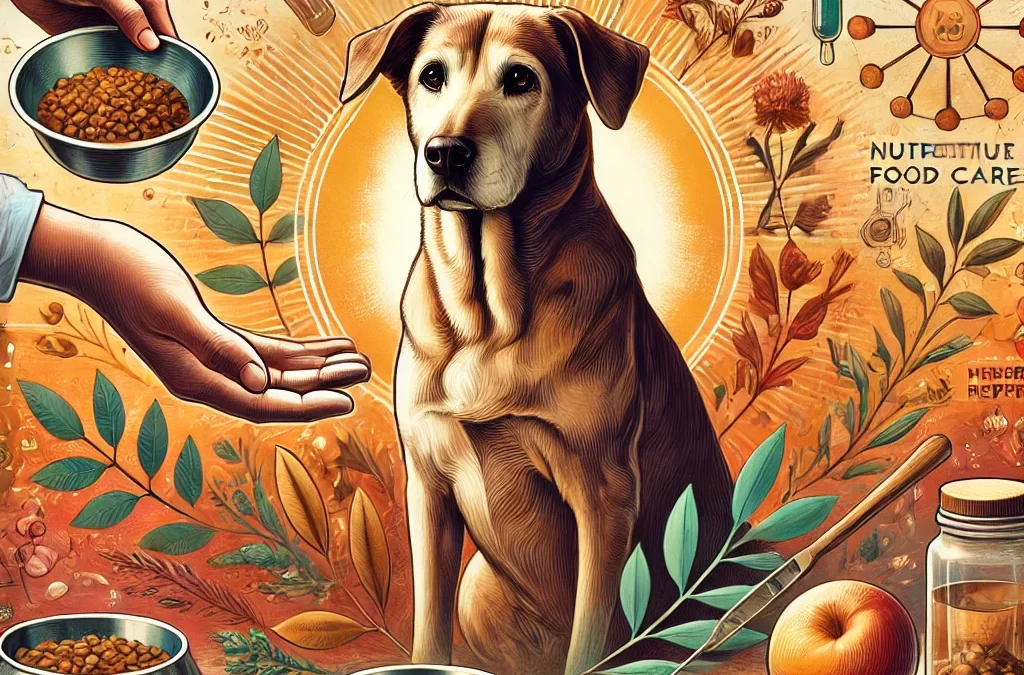
door TCMVET | 18 dec. 2024 | Hondenkanker en tumoren
Inleiding: De stille vijand in de kankerzorg bij honden
Kankercachexie, een complex metabool syndroom dat wordt gekenmerkt door ernstig gewichtsverlies en spierverlies, is een stille maar dodelijke aandoening die veel honden met kanker treft. Cachexie wordt vaak overschaduwd door de primaire ziekte en heeft een aanzienlijke impact op de kwaliteit van leven, de reactie op behandeling en de algehele overleving van getroffen huisdieren. Het begrijpen en aanpakken van deze aandoening is cruciaal voor holistische kankerzorg bij honden.
What is Cancer Cachexia?
Kankercachexie is meer dan alleen gewichtsverlies. Het is een multifactoriële aandoening die wordt aangestuurd door de wisselwerking van systemische ontsteking, metabolische dysregulatie en de metabolische eisen van de tumor. Belangrijkste kenmerken zijn:
- Verlies van spiermassa: In tegenstelling tot simpele uithongering leidt cachexie tot spierverlies dat niet kan worden teruggedraaid door alleen een hogere calorie-inname.
- Appetite Changes: Honden kunnen minder interesse in eten (anorexia) of een veranderde smaakvoorkeur vertonen.
- Systemische ontsteking: Tumor-geïnduceerde ontstekingen verergeren metabolische onevenwichtigheden, waardoor de aandoening verder verergert.
Waarom ontstaat kankercachexie bij honden?
De exacte mechanismen van kankercachexie zijn complex en variëren afhankelijk van het type en stadium van kanker. Factoren die bijdragen aan deze aandoening zijn onder andere:
- Tumor Metabolism:Bepaalde tumoren scheiden stoffen af die de normale stofwisselingsprocessen verstoren, waardoor spieren en vet worden afgebroken.
- Cytokinen en hormonen: Verhoogde niveaus van pro-inflammatoire cytokinen (bijv. TNF-alfa) en hormonale onevenwichtigheden spelen een belangrijke rol bij het ontstaan van cachexie.
- Voedingstekorten: Een verminderde voedselinname en een verminderde opname van voedingsstoffen verslechteren de conditie van de hond.
Kankercachexie bij honden herkennen
Vroege detectie is de sleutel tot het beheersen van kankercachexie. Let op deze signalen:
- Onverklaarbaar gewichtsverlies ondanks voldoende voedselinname
- Spierverlies, vooral rond de wervelkolom en achterbenen
- Vermoeidheid en verminderde activiteitsniveaus
- Veranderingen in eetlust of eetgedrag
Innovatieve managementstrategieën
Hoewel er geen one-size-fits-all-oplossing is, kan een multimodale aanpak helpen cachexie bij honden te beheersen. Hier zijn enkele opkomende strategieën:
- Aangepaste voedingsondersteuning:Een dieet rijk aan hoogwaardige eiwitten, omega 3-vetzuren en specifieke aminozuren zoals glutamine kan helpen de spiermassa te behouden.
- Appetite Stimulants: Medicijnen zoals mirtazapine of capromoreline kunnen de eetlust en de voedselinname verbeteren.
- Anti-Inflammatory Therapies: Omega-3-supplementen en medicijnen die gericht zijn op ontstekingsreacties kunnen de cytokineactiviteit verminderen.
- Metabole modulatoren: Onderzoek naar medicijnen zoals anamoreline en ghreline-mimetica lijkt veelbelovend voor het terugdraaien van spierverlies.
De rol van integratieve geneeskunde
Natuurlijke therapieën, zoals Traditionele Chinese Geneeskunde (TCM), hebben laten zien dat ze symptomen kunnen verlichten. Kruiden zoals astragalus en ginseng kunnen de immuunfunctie en energieniveaus ondersteunen, terwijl acupunctuur de eetlust kan verbeteren en ontstekingen kan verminderen.
Vooruitkijken: de noodzaak van verder onderzoek
Ondanks de vooruitgang blijft kankercachexie onderbelicht in de diergeneeskunde. Samenwerking tussen dierenartsen, onderzoekers en huisdiereigenaren is essentieel om nieuwe therapieën te ontwikkelen en de uitkomsten voor getroffen honden te verbeteren.
Conclusie: hoop door innovatie
Hoewel kankercachexie een grote uitdaging vormt, bieden vorderingen in het begrijpen en behandelen van deze aandoening hoop. Door een holistische en proactieve aanpak te hanteren, kunnen we de kwaliteit van leven van honden die vechten tegen kanker verbeteren en hen helpen om met waardigheid en comfort van hun gouden jaren te genieten.
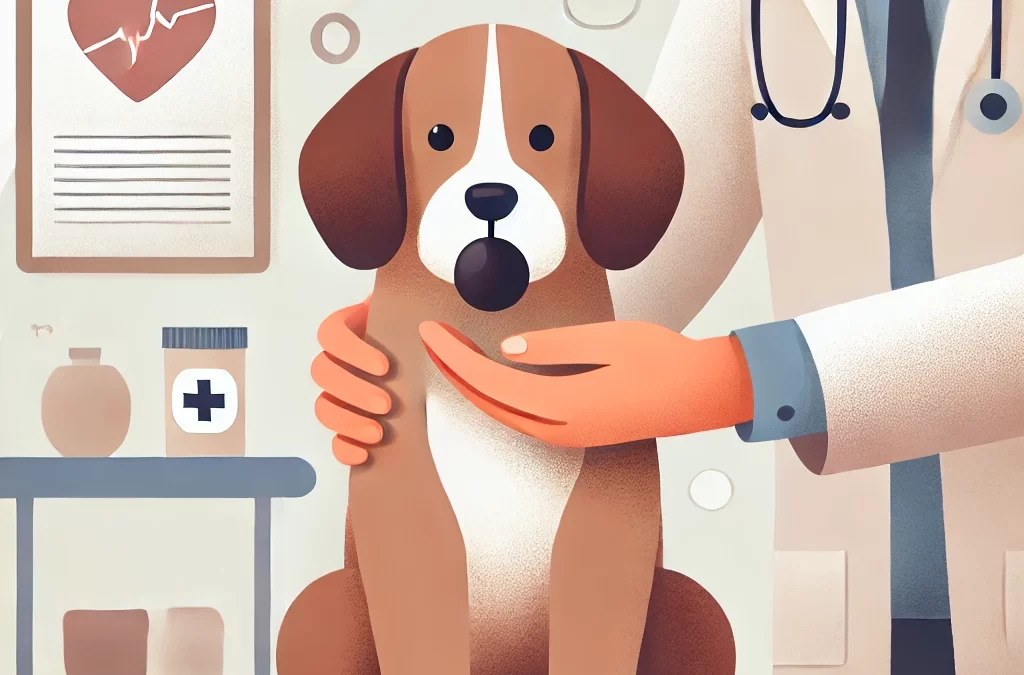
door TCMVET | 16 dec. 2024 | Hondenkanker en tumoren
Orale maligne melanoom (OMM) bij honden is een sluipende tegenstander. Bekend om zijn agressieve aard en snelle verspreiding, is het een diagnose die angst inboezemt bij huisdiereigenaren. Maar OMM is meer dan alleen een medische aandoening: het is een oproep tot actie voor huisdiereigenaren om waakzaamheid, innovatie en holistische zorg te omarmen. Laten we dit uitdagende onderwerp met een frisse blik onderzoeken, waarbij we zowel wetenschap als hoop onderzoeken.
Wat is oraal maligne melanoom?
Maligne oraal melanoom is een type kanker dat ontstaat in de melanocyten, cellen die verantwoordelijk zijn voor de pigmentproductie in de huid en slijmvliezen. Hoewel het meestal in de mond voorkomt, stopt deze kanker daar niet. Het staat bekend om zijn vermogen om nabijgelegen weefsels binnen te dringen en uit te zaaien naar verre organen zoals de longen en lymfeklieren.
Deze aandoening komt het meest voor bij honden van middelbare leeftijd tot oudere honden, met name rassen met donker gepigmenteerd tandvlees, zoals Cocker Spaniels, Chow Chows en Scottish Terriers. Ondanks de grimmige reputatie kan het begrijpen van de symptomen en behandelingsopties van OMM eigenaren in staat stellen om weloverwogen beslissingen te nemen.
De signalen herkennen
Maligne melanoom van de mond blijft vaak onopgemerkt totdat het vergevorderd is, waardoor regelmatige controles van de mond cruciaal zijn. Veelvoorkomende symptomen zijn:
- Een donkere of onregelmatige massa in de mond, op het tandvlees of op de lippen.
- Bloeden, een slechte adem of kwijlen.
- Moeilijkheden met eten, kauwen of slikken.
- Zwelling van het gezicht of vergrote lymfeklieren.
Als u een van deze symptomen opmerkt, raadpleeg dan onmiddellijk uw dierenarts. Vroege detectie kan de uitkomst aanzienlijk beïnvloeden.
Verder kijken dan traditionele behandelingen: innovatie omarmen
Conventionele behandelingen voor OMM omvatten chirurgie, radiotherapie en chemotherapie. Hoewel ze in veel gevallen effectief zijn, zijn deze opties niet altijd toegankelijk of betaalbaar. Hier zijn enkele innovatieve en integratieve benaderingen die aandacht krijgen:
- Immunotherapie vaccins: Een game-changer in oncologie, OMM-specifieke vaccins, zoals het canine melanoma vaccin (ONCEPT®), stimuleren het immuunsysteem van de hond om kankercellen te bestrijden. Deze geavanceerde behandeling heeft veelbelovende resultaten laten zien in het verlengen van de overlevingstijd.
- Fotodynamische therapie (PDT): Deze techniek gebruikt licht-geactiveerde medicijnen om kankercellen selectief te vernietigen, waarbij omliggend gezond weefsel gespaard blijft. Het is een minder invasieve optie voor bepaalde gevallen.
- Holistische supplementen: Natuurlijke supplementen zoals curcumine (gevonden in kurkuma), medicinale paddenstoelen en omega-3-vetzuren worden onderzocht op hun ontstekingsremmende en immuunversterkende eigenschappen. Raadpleeg altijd een dierenarts voordat u supplementen gaat gebruiken.
De rol van voeding bij herstel
Een kankerdiagnose vraagt om een verandering in dieetstrategieën. Honden die vechten tegen OMM hebben baat bij een dieet dat is afgestemd op hun metabolische behoeften. Focus op:
- Hoogwaardige eiwitten: Mager vlees en vis om spiermassa te behouden.
- Gezonde vetten: Omega-3-vetzuren bestrijden ontstekingen en ondersteunen de algehele gezondheid.
- Opties met weinig koolhydraten: Kankercellen gedijen goed op suiker. Door de inname van koolhydraten te beperken, kunt u hun groei vertragen.
Zelfgemaakte, door de dierenarts goedgekeurde maaltijden kunnen een geweldige manier zijn om ervoor te zorgen dat uw hond optimale voeding binnenkrijgt.
Emotionele en praktische ondersteuning voor huisdiereigenaren
Zorgen voor een hond met OMM is emotioneel even veeleisend als uitdagend. Zo navigeer je door deze reis:
- Creëer een dagelijkse verzorgingsroutine: Door consistent te zijn, kunt u stress voor zowel u als uw hond verminderen.
- Zoek steun bij de gemeenschap: Online forums en lokale ondersteuningsgroepen voor huisdiereigenaren die met kanker bij hun hond te maken hebben, kunnen troost en waardevolle inzichten bieden.
- Ontdek de mogelijkheden voor palliatieve zorg: Als curatieve behandeling geen optie is, richt u dan op pijnbestrijding en het verbeteren van de kwaliteit van leven van uw hond.
Een glimp van hoop
Hoewel oraal maligne melanoom bij honden een geduchte vijand is, veranderen ontwikkelingen in de diergeneeskunde en integrale zorg het verhaal. Vroege detectie, innovatieve behandelingen en een focus op holistisch welzijn stellen huisdiereigenaren in staat om terug te vechten tegen deze ziekte.
De diagnose van uw hond definieert de reis niet, het is een hoofdstuk in het verhaal van hun veerkracht, liefde en de band die u deelt. Blijf vragen stellen, oplossingen zoeken en elk moment koesteren.
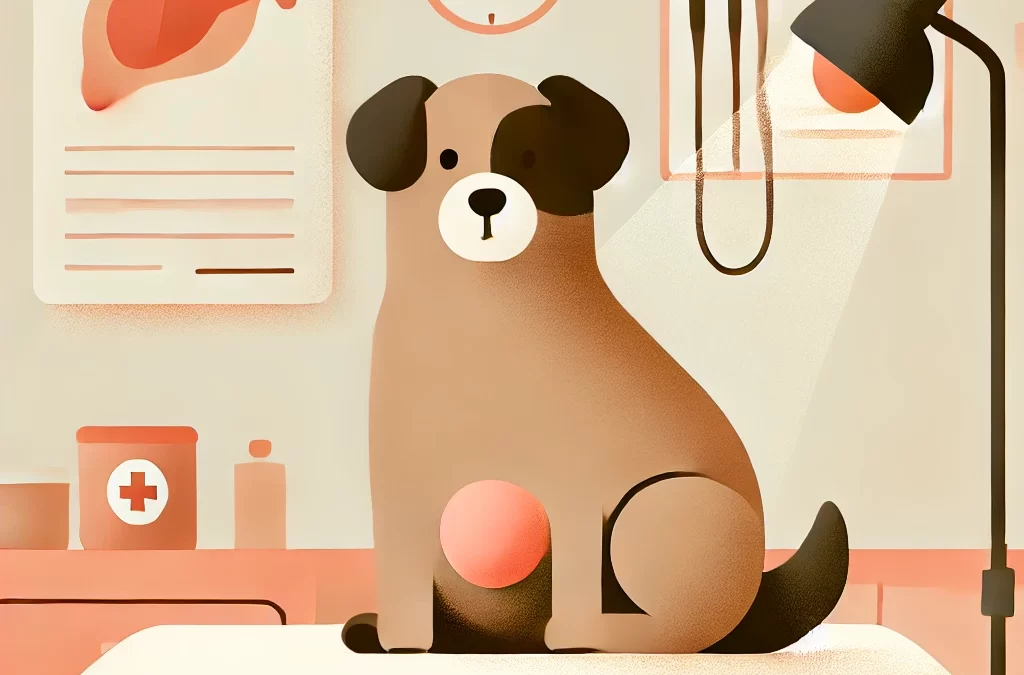
door TCMVET | 16 dec. 2024 | Hondenkanker en tumoren
Het ontdekken van een knobbel op de buik van uw hond kan alarmerend zijn. Als huisdiereigenaren is onze eerste reactie vaak bezorgdheid, maar niet alle knobbels zijn gevaarlijk. Sterker nog, veel zijn goedaardig en beheersbaar met de juiste verzorging. Om u te helpen deze situatie te doorstaan, volgt hier een frisse kijk op het begrijpen, identificeren en aanpakken van knobbels in de buik bij honden.
Wat is precies een maagknobbel?
Een maagknobbel bij honden verwijst naar een abnormale massa of zwelling in het buikgebied. Deze kunnen variëren in grootte, vorm en textuur: sommige voelen zacht en beweeglijk aan, terwijl andere stevig kunnen zijn of vastzitten aan onderliggende weefsels.
De sleutel tot het omgaan met zulke bulten ligt in observatie en tijdige actie. Laten we, voordat we conclusies trekken, de meest voorkomende oorzaken achter deze groeisels onderzoeken.
Veelvoorkomende oorzaken van maagknobbels
- Lipomen (vetgezwellen): Dit zijn goedaardige, zachte en langzaam groeiende bulten die vaak voorkomen bij oudere honden. Lipomen vormen zelden een gezondheidsrisico en zijn meestal meer een cosmetisch probleem.
- Hematomen of abcessen: Als uw hond onlangs een trauma heeft gehad, kan de bult een hematoom zijn (een verzameling bloed onder de huid) of een abces veroorzaakt door een infectie. Deze zijn vaak warm en gevoelig bij aanraking.
- Hernia's: Hernia's ontstaan wanneer interne weefsels of organen door een zwakke plek in de buikwand heen duwen. Ze kunnen zacht aanvoelen en verminderen wanneer er zachtjes op wordt gedrukt.
- Kwaadaardige tumoren: Helaas zijn sommige knobbels kankerachtig. Mastceltumoren, wekedelensarcomen en andere kwaadaardige aandoeningen vereisen vaak onmiddellijke veterinaire aandacht en behandeling.
- Cysten of talgkliergroei: Dit zijn vaak met vocht gevulde zakjes of verstopte klieren die op de maag van uw hond kunnen verschijnen. Ze zijn over het algemeen ongevaarlijk, maar kunnen drainage of een kleine operatie vereisen als ze te groot worden.
Tekenen die onmiddellijke aandacht vereisen
Hoewel niet alle maagknobbels reden tot bezorgdheid zijn, zijn er bepaalde symptomen die erop wijzen dat een spoedbezoek aan de dierenarts noodzakelijk is:
- De bult wordt snel groter.
- Uw hond lijkt pijn te hebben als hij de plek aanraakt.
- De knobbel is hard, onbeweeglijk of onregelmatig van vorm.
- Er is sprake van roodheid, zwelling of afscheiding uit het gebied.
- Uw hond vertoont tekenen van lusteloosheid, verlies van eetlust of andere systemische problemen.
Wat te doen als u een knobbel ontdekt
- Houd de bult in de gaten: Houd de grootte, textuur en het gedrag bij. Door elke paar dagen foto's te maken, kunt u eventuele veranderingen opmerken.
- Plan een bezoek aan de dierenarts: Uw dierenarts kan een lichamelijk onderzoek uitvoeren en diagnostische tests aanbevelen, zoals een fijnenaaldaspiratie, biopsie of echografie, om de aard van de knobbel te bepalen.
- Overweeg behandelingsopties: Afhankelijk van de diagnose kan uw dierenarts observatie, medicatie, operatie of andere therapieën voorstellen. Voor goedaardige gezwellen zoals lipomen is behandeling mogelijk niet nodig, tenzij de bult ongemak veroorzaakt.
- Ontdek natuurlijke remedies (met goedkeuring van de dierenarts): Voor niet-kwaadaardige gezwellen wenden sommige huisdiereigenaren zich tot natuurlijke supplementen zoals kurkuma, omega-3-vetzuren of kruidenbehandelingen die de algehele immuungezondheid bevorderen. Raadpleeg altijd uw dierenarts voordat u een nieuw supplement introduceert.
Preventietips voor een gezonde hond
- Regelmatige controles: Vroege detectie is de sleutel tot het effectief behandelen van knobbels. Regelmatige bezoeken aan de dierenarts zorgen ervoor dat eventuele veranderingen snel worden aangepakt.
- Gebalanceerd dieet: Een dieet dat rijk is aan voedingsstoffen kan de algemene gezondheid en immuniteit van uw hond ondersteunen.
- Behoud een gezond gewicht: Obesitas verhoogt het risico op vettige tumoren en andere gezondheidsproblemen. Houd uw hond actief en op een ideaal gewicht.
- Huidverzorging: Door de vacht en huid van uw hond regelmatig te verzorgen en te inspecteren, kunt u afwijkingen vroegtijdig opsporen.
Een woord van troost
Niet elke knobbel is levensbedreigend en vooruitgang in de diergeneeskunde heeft de diagnose en behandeling effectiever gemaakt dan ooit. Door oplettend en proactief te blijven, kunt u ervoor zorgen dat uw hond gelukkig en gezond blijft.
Als u een knobbel in uw maag opmerkt, haal dan diep adem en neem contact op met uw dierenarts. Samen vinden jullie de beste weg vooruit voor uw harige metgezel.
Tags: maagknobbel bij honden, oorzaken van knobbels bij honden, behandeling van knobbels bij honden, gezondheidszorg voor honden, goedaardige tumoren bij honden, natuurlijke remedies voor honden
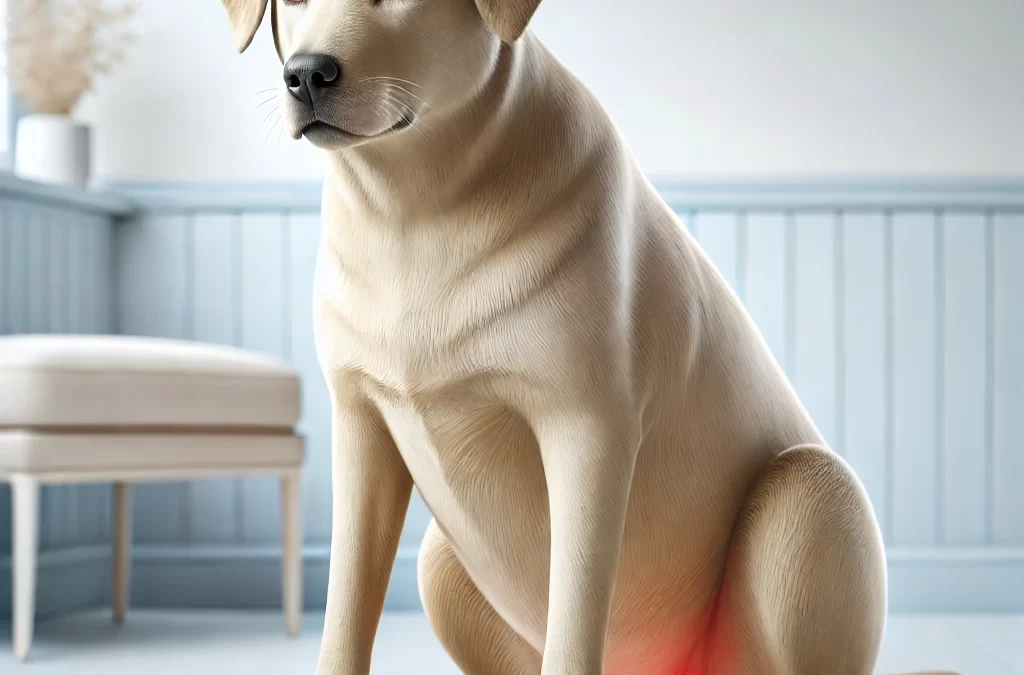
door TCMVET | 14 dec. 2024 | Hondenkanker en tumoren
Abnormale gezwellen in de onderste darmen van honden, hoewel niet zo vaak voorkomend als andere gezondheidsproblemen, zijn een zorgwekkend fenomeen dat vaak onder de radar blijft. Deze gezwellen, die kunnen variëren van goedaardige poliepen tot kwaadaardige tumoren, hebben invloed op de spijsvertering, het algehele comfort en de gezondheid op de lange termijn van een hond. Het begrijpen van de oorzaken, symptomen en behandelingsopties is cruciaal om een betere kwaliteit van leven voor uw harige metgezel te garanderen.
Wat zijn abnormale gezwellen in de onderste darmen?
De term "abnormale gezwellen" omvat een verscheidenheid aan aandoeningen die het onderste deel van het darmkanaal aantasten, waaronder de dikke darm, het rectum en de anus. Deze gezwellen kunnen zijn:
- Poliepen: Goedaardige, niet-kankerachtige gezwellen die ongemak kunnen veroorzaken, maar zich zelden verspreiden.
- Adenocarcinomen: Kwaadaardige tumoren die ontstaan vanuit kliercellen, vaak agressief en invasief.
- Leiomyosarcomen: Zeldzame, kwaadaardige gezwellen die de gladde spierlaag van de darmen aantasten.
- Lymfomen: Kanker die het lymfeweefsel in de darmen aantast, komt vaak voor bij honden met een aanleg voor maag-darmziekten.
Oorzaken van lagere darmgroei bij honden
De exacte oorzaken variëren, maar er zijn verschillende factoren die bijdragen aan de ontwikkeling van abnormale gezwellen:
- Age: Oudere honden zijn gevoeliger voor darmtumoren als gevolg van celveroudering en mutaties.
- Raspredispositie: Rassen zoals Duitse herders en collies hebben een hoger risico op maag-darmkanker.
- Dieet en omgeving: Een dieet van slechte kwaliteit, blootstelling aan gifstoffen of chronische darmirritatie kunnen leiden tot abnormale celgroei.
- Chronische ontsteking: Aandoeningen zoals inflammatoire darmziekte (IBD) vormen een broedplaats voor abnormale gezwellen.
Tekenen en symptomen waar u op moet letten
Abnormale gezwellen in de onderste darmen vertonen vaak subtiele of dubbelzinnige symptomen, waardoor vroege detectie een uitdaging is. Belangrijke signalen zijn onder meer:
- Chronische diarree: Aanhoudende, dunne ontlasting, vaak met slijm of bloed.
- Constipatie of persen: Moeilijkheden bij het passeren van ontlasting vanwege obstructie veroorzaakt door gezwellen.
- Bloed in de ontlasting (hematochezia): Vaak is helderrood of donker teerachtig bloed een indicatie.
- Buikpijn: Honden kunnen symptomen vertonen als janken, rusteloosheid of een gebogen houding.
- Weight Loss: Unexplained weight loss despite a normal appetite.
- Lethargy and Weakness: Een afname van het energieniveau als gevolg van bloedarmoede of systemische effecten van de groei.
Diagnose: het verborgen probleem onthullen
Voor de diagnose van gezwellen in de onderste darm is een combinatie van klinische onderzoeken en geavanceerde diagnostiek nodig:
- Fysiek onderzoek: Bij een rectaal onderzoek kunnen voelbare gezwellen in de onderste urinewegen zichtbaar zijn.
- In beeld brengen: Met behulp van röntgenfoto's, echografieën en CT-scans kunnen tumoren en hun locatie in beeld worden gebracht.
- Endoscopie: Met een camera die in de dikke darm wordt ingebracht, kan afwijkend weefsel worden geïdentificeerd en soms kan er een biopsie worden uitgevoerd.
- Biopsie: Weefselmonsters bevestigen of de tumor goedaardig of kwaadaardig is, en bepalen op basis daarvan de behandeling.
Behandelingsopties: op maat voor elk geval
De behandeling varieert afhankelijk van het type, de locatie en het stadium van de groei:
- Chirurgisch verwijderen: De eerstelijnsbehandeling voor lokale gezwellen, met name goedaardige poliepen of kleine kwaadaardige tumoren.
- Chemotherapie: Aanbevolen voor kankers die uitgezaaid zijn of niet volledig operatief verwijderd kunnen worden.
- Bestralingstherapie: Wordt gebruikt in combinatie met een operatie bij agressieve tumoren.
- Palliatieve zorg: Gericht op pijnbestrijding en het verbeteren van het comfort van de hond bij gevorderde of ongeneeslijke gevallen.
Holistische ondersteuning voor de spijsvertering
Hoewel medische behandelingen de primaire aandoening aanpakken, kunnen holistische benaderingen aanvullende ondersteuning bieden:
- Diëten met veel vezels: Bevordert een soepelere spijsvertering en vermindert irritatie in de dunne darm.
- Probiotica: Verbetert de darmflora en ondersteunt de algemene gezondheid van de darmen.
- Kurkuma (curcumine): Bekend om zijn ontstekingsremmende en potentiële antikankereigenschappen.
- CBD-olie: Helpt ontstekingen en pijn te verminderen en verbetert zo de levenskwaliteit van de hond.
Preventieve maatregelen: het risico verminderen
Hoewel niet alle gezwellen voorkomen kunnen worden, zijn er stappen die u kunt ondernemen om het risico voor uw hond te verlagen:
- Regelmatige controles: Jaarlijkse veterinaire onderzoeken helpen om afwijkingen vroegtijdig te ontdekken.
- Hoogwaardige diëten: Zorg voor uitgebalanceerde, voedzame voeding om de maag-darmstress te minimaliseren.
- Controleer de gezondheid van uw ontlasting: Let op veranderingen in de ontlasting en stoelgang van uw hond.
- Beperk blootstelling aan toxines: Geef uw hond geen voedsel van lage kwaliteit en stel hem niet bloot aan schadelijke chemicaliën.
De emotionele tol voor huisdiereigenaren
Zorgen voor een hond met darmgezwellen kan emotioneel belastend zijn. Het is normaal om je angstig of overweldigd te voelen, maar onthoud dat je niet alleen bent. Veel bronnen, waaronder ondersteuningsgroepen en dierenartsen, kunnen je door deze reis heen helpen.
Conclusie: Kennis is macht
Abnormale gezwellen in de onderste darmen van honden lijken misschien ontmoedigend, maar met vroege detectie en proactieve zorg kunnen veel honden een bevredigend leven leiden. Blijf waakzaam, vraag regelmatig om veterinair advies en geef uw viervoeter de best mogelijke zorg.
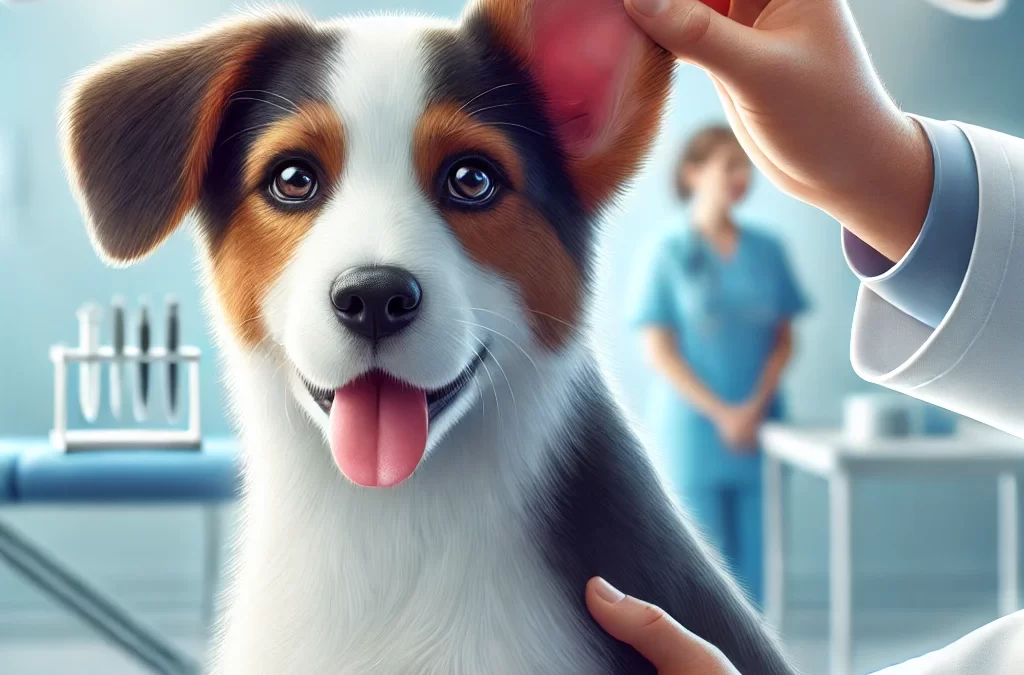
door TCMVET | 14 dec. 2024 | Hondenkanker en tumoren
Als het gaat om bultjes op de oren van een hond, is een mogelijkheid die eigenaren vaak verrast een histiocytoom. Deze goedaardige gezwellen komen vaak voor bij jongere honden en kunnen alarmerend lijken vanwege hun snelle ontwikkeling en prominente locatie. Ze zijn echter meestal ongevaarlijk en verdwijnen vaak vanzelf. Laten we eens kijken wat histiocytomen uniek maakt en hoe u uw harige vriend het beste kunt verzorgen.
Wat is een histiocytoom?
Een histiocytoom is een goedaardige tumor die ontstaat uit de Langerhans-cellen, een type immuuncel dat zich in de huid bevindt. Deze tumoren worden het vaakst gezien bij honden jonger dan drie jaar en komen meestal voor op het hoofd, de oren of de ledematen.
In het geval van het oor vormen histiocytomen zich vaak op het buitenste oppervlak of aan de rand, waardoor een zichtbare bult ontstaat die huisdiereigenaren kan verontrusten. Ondanks hun dramatische verschijning worden histiocytomen beschouwd als een van de meest goedaardige vormen van gezwellen bij honden.
Waarom ontstaan histiocytomen bij honden?
De exacte oorzaak van histiocytomen is onbekend, maar men denkt dat ze verband houden met een overactieve immuunreactie bij jongere honden. Rassen zoals Boxers, Labradors en Bulldogs lijken een hogere aanleg te hebben, hoewel elk ras er een kan ontwikkelen.
Hoe een histiocytoom op het oor te identificeren
Histiocytomen onderscheiden zich door hun uiterlijk en gedrag, waardoor ze relatief gemakkelijk te herkennen zijn:
- Verschijning: Een verheven, ronde, rode bult, vaak haarloos en glad. Op het oor kan het er bijzonder uitgesproken uitzien vanwege de dunne huid en het ontbreken van vacht.
- Maat: Meestal klein, ongeveer 0,5 tot 2 cm in diameter.
- Textuur: Voelt stevig aan, met een licht gezwollen of glanzend oppervlak.
- Gedrag: In tegenstelling tot kwaadaardige tumoren veroorzaken histiocytomen doorgaans geen ongemak, tenzij ze worden bekrast of geïnfecteerd raken.
Moet u zich zorgen maken?
Een van de meest geruststellende aspecten van histiocytomen is dat ze zelfbeperkend, wat betekent dat ze vaak zonder interventie binnen 2 tot 3 maanden verdwijnen. Echter, een veterinaire consultatie is cruciaal om de diagnose te bevestigen en ernstigere aandoeningen uit te sluiten zoals:
- Mestceltumoren
- Plaveiselcelcarcinoom
- Oorontstekingen of abcessen
Wat u kunt verwachten tijdens de diagnose
Dierenartsen gebruiken doorgaans de volgende methoden om een histiocytoom te identificeren:
- Fysiek onderzoek: Een gedetailleerde inspectie van de bult en de algemene gezondheid van de hond.
- Fijne naaldaspiratie (FNA): Er wordt een klein monster cellen genomen voor microscopische analyse.
- Biopsie: In zeldzame gevallen kan een biopsie worden uitgevoerd voor verdere bevestiging.
Behandelings- en zorgopties
De meeste histiocytomen genezen vanzelf, maar in bepaalde gevallen kan een interventie nodig zijn:
- Geen behandeling nodig: Als de bult geen problemen oplevert voor de hond, kan deze op natuurlijke wijze verdwijnen.
- Chirurgisch verwijderen: In zeldzame gevallen, wanneer de tumor irritatie veroorzaakt of langzaam geneest, kan een dierenarts aanraden om de tumor te verwijderen.
- Topical Treatments: Als het histiocytoom gaat zweren, kunnen antibiotische crèmes of sprays een infectie voorkomen.
Tips voor thuiszorg
Terwijl u wacht tot het histiocytoom is verdwenen, kunt u de volgende stappen ondernemen om ervoor te zorgen dat uw hond zich prettig blijft voelen:
- Voorkom krabben: Gebruik een halsband als uw hond overmatig aan zijn oor krabt. Dit kan namelijk leiden tot bloedingen of een infectie.
- Houd de groei in de gaten: Houd de grootte, kleur en textuur van de bult in de gaten. Snelle veranderingen kunnen een vervolgbezoek rechtvaardigen.
- Maak het gebied schoon: Maak het oor voorzichtig schoon met een door uw dierenarts aanbevolen oplossing om het risico op secundaire infecties te verkleinen.
Wat is het verschil tussen een oorhistiocytoom en een oorkanker?
Histiocytomen op het oor kunnen opvallender zijn vanwege de gevoelige locatie van het oor. Ze kunnen ervoor zorgen dat het oor er asymmetrisch of slap uitziet, en honden kunnen vaker hun hoofd schudden. Deze specifieke signalen maken toezicht en verzorging nog belangrijker.
Een natuurlijke aanpak om het genezingsproces van uw hond te ondersteunen
Sommige huisdiereigenaren onderzoeken natuurlijke therapieën als aanvulling op traditionele veterinaire zorg. Hoewel deze methoden geen genezing zijn, kunnen ze de algehele gezondheid van de huid ondersteunen:
- Omega-3 vetzuren: Bevordert een gezonde immuunreactie en vermindert ontstekingen.
- Calendula crème: Een verzachtend kruidenmiddel om irritatie rond de bult te verlichten.
- CBD-olie: Kan helpen bij het verminderen van krabben en stress die gepaard gaan met ongemak.
Wanneer u een dierenarts moet raadplegen
Ook al zijn histiocytomen goedaardig, raadpleeg uw dierenarts als u het volgende opmerkt:
- De bult groeit snel of verandert van textuur.
- Aanhoudend krabben, bloeden of afscheiding.
- Het histiocytoom is na 3 maanden niet afgenomen.
Laatste gedachten
Een histiocytoom op het oor van uw hond lijkt op het eerste gezicht misschien verontrustend, maar het is doorgaans een onschuldige aandoening die met weinig tot geen interventie verdwijnt. Door de unieke aard ervan te begrijpen en door aandachtige zorg te bieden, kunt u ervoor zorgen dat uw hond gedurende het hele proces gelukkig en gezond blijft.






